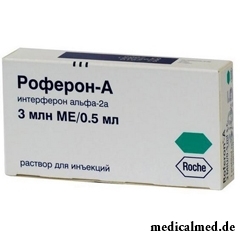





Roferon-A
Application instruction:
 Roferon-A – immunomodulatory drug with antiviral and antineoplastic action.
Roferon-A – immunomodulatory drug with antiviral and antineoplastic action.
Form of release and structure
Dosage form – solution for hypodermic introduction: colourless or light yellow color transparent liquid (on 0,5 ml in the syringe tube with the glass case and the plastic piston, in a cardboard pack 1 unit-dose syringe complete with a container with an injection cannula; on 0,6 ml in a glass cartridge, in the cardboard pallet 1 cartridge, in a cardboard pack 1 pallet).
Roferona-A active ingredient – interferon alpha 2а:
- 1 unit-dose syringe: 3 million, 4,5 million, 6 million or 9 million International Units (IU);
- 1 cartridge: 18 million ME.
Auxiliary components: benzyl alcohol, sodium chloride, polysorbate 80, ammonium acetate, sodium hydroxide or acetic acid ice, water for injections.
Indications to use
- viral pathologies: sharp-pointed condylomas, an active form of chronic hepatitis B at adult patients with a marker of virus replication, an active form of chronic hepatitis C at adult patients who have antibodies to a virus of hepatitis C or a superactivity of alaninaminotranspherase (ALT) in the absence of signs of a hepatic decompensation (a class A on Chayld-Pyyu) and HCV RNA in blood serum (it is desirable for Roferon-A to appoint in a combination with ribaviriny, also use is shown to the patients who had a disease recurrence after therapy cancellation by interferon an alpha);
- new growths of system of a hemopoiesis and lymphatic system: a multiple myeloma, the T-cellular lymphoma of skin, a hairy cell leukosis, a chronic Ph-positive myeloleukemia, a thrombocytosis against the background of myeloproliferative diseases, a nekhodzhkinsky lymphoma with low degree of a zlokachestvennost (in a combination with chemotherapy – with beam methods of treatment or without them);
- solid tumors: Kaposha's sarcoma at patients with AIDS (at absence in the anamnesis of opportunistic infections), a metastatic melanoma, a widespread nephrocellular carcinoma, a melanoma (after carrying out a surgical resection of a tumor more than 1,5 mm thick) in the absence of the remote metastasises and damage of lymph nodes.
Contraindications
- the expressed functional disturbances of a liver, myeloid sprout of a hemopoiesis, kidneys;
- chronic hepatitis with cirrhosis or the expressed decompensation;
- serious illness of heart, including the anamnesis;
- functional disturbances of the central nervous system, including convulsive frustration;
- breastfeeding;
- combination therapy with ribaviriny during pregnancy;
- age up to three years;
- individual intolerance of components of drug.
Besides, purpose of Roferona-A is contraindicated to patients with the chronic hepatitis which is at the same time receiving or recently underwent treatment by immunodepressants except short-term therapy with steroids.
It is impossible to use drug at the patient with a chronic form of a myeloleukemia if it has a HLA identical relative and in the near future performing allogenic transplantation of marrow is possible.
Route of administration and dosage
Solution is intended for hypodermic (п / to) introductions.
The recommended dosing:
- sharp-pointed condylomas: on 1-3 million ME 3 times a week within 4-8 weeks;
- chronic viral hepatitis of B: adults – on 4,5-9 million ME 3 times a week, treatment duration – 16-24 weeks. Further the dose can be adjusted taking into account individual portability. In the absence of improvement after 12-16 weeks of therapy drug withdrawal is possible. A safe and effective dose 7,5 million ME on 1 sq.m of a body surface of the child for children over three years are considered;
- chronic viral hepatitis of C: primary therapy in a combination with ribaviriny – on 3 million ME 3 times a week within 24 weeks. A combination therapy with ribaviriny at a recurrence at adults (after temporary effect of monotherapy by interferon alpha) – on 4,5 million ME 3 times a week within 24 weeks. The course of treatment depends on a genotype of a virus and other initial characteristics of a condition of the patient and can proceed up to 52 weeks. Monotherapy of Roferonom-A (in the presence of contraindications and/or intolerance of a ribavirin) – on 3-6 million ME 3 times a week, a course of treatment – 24-52 weeks. In the absence of normalization of the ALT level after 12 weeks of use of drug further therapy is cancelled. At a disease recurrence after the partial or full response to therapy resuming of treatment in initial or higher dose is possible;
- hairy cell leukosis: an initial dose – on 3 million ME of 1 times a day within 16-24 weeks. To patients with hypersensitivity decrease in a daily dose to 1,5 million ME and/or frequency rates of introduction to 3 weekly is possible. A maintenance therapy – on 3 million ME (1,5 million ME at bad portability) 3 times a week. At clinical effect after 24 weeks of treatment the course is continued, at absence – administration of drug is cancelled. Duration of treatment should not exceed 80 weeks;
- multiple myeloma: an initial dose – on 3 million ME 3 times a week, then at good tolerance weekly increase a dose, the most tolerable single dose can fluctuate from 9 to 18 million ME, frequency rate of introduction – 3 times a week. In the absence of the expressed intolerance and symptoms of progressing of a disease it is possible to use drug a long time;
- The T-cellular lymphoma of skin at patients is more senior than 18 years with the progressing disease form including which are not answering traditional therapy or having contraindications to its carrying out: an initial dose – 3 million ME of 1 times a day within three days, then from 4 to 6 day – on 9 million ME, from 7 to 84 day – on 18 million ME a day. At a positive tendency after 12 weeks of therapy to the patient appoint a maintenance dose which corresponds to an individual most tolerable dose (no more than 18 million ME), with frequency rate of introduction 3 times a week. For achievement of full and long remission it is necessary to continue treatment from 52 to 172 weeks;
- the myelosis (HML) at patients is more senior than 18 years: an initial dose – on 3 million ME a day from 1 to 3 day, on 6 million ME from 4 to 6 day, on 9 million ME from 7 to 84 day. A course of treatment – not less than 8 weeks, it is desirable – 12 weeks, use of drug is continued before full hematologic remission, but by no more than 78 weeks. If dynamics of hematologic indicators is absent, treatment is stopped. After achievement of full hematologic remission of the patient transfer to a daily dose 9 million ME (an optimum dose) daily or 3 times a week. Treatment is continued before achievement of cytogenetic remission. Drug provides stable cytogenetic remission for more than 170 weeks;
- the thrombocytosis connected with myeloproliferative pathologies (except HML): an initial dose – on 3 million ME of 1 times a day from 1 to 3 day, then on 6 million ME from 4 to 30 day. A maintenance therapy – on 1-3 million ME 2-3 times a week;
- nekhodzhkinsky lymphoma with low degree of a zlokachestvennost (after the standard chemotherapy including radiation therapy or without it): a maintenance therapy in a single dose of 3 million ME 3 times a week. Treatment duration – not less than 52 weeks. Treatment should be begun right after improvement of a condition of the patient, usually in 4-6 weeks after beam or chemotherapy. Along with traditional schemes of chemotherapy (in a combination with Prednisolonum, cyclophosphamide, Vincristinum and doxorubicine) use of Roferona-A it is possible to appoint from 22 to 26 day of each 28-day cycle in a dose 6 million ME to 1 sq.m of a body surface of the patient;
- Kaposha's sarcoma at patients with AIDS is aged more senior than 18 years in the absence of opportunistic infections in the anamnesis: an initial dose – on 3 million ME a day, within 10-12 weeks the daily dose is gradually raised to 18-36 million ME according to the scheme: the first three days – on 3 million ME a day, from 4 to 6 day – on 9 million ME, from 7 to 9 day – on 18 million ME, from 10 to 84 day (at good tolerance) – to 36 million ME a day. The maintenance dose corresponds to an individual most tolerable dose, but it is not higher than 36 million ME, with frequency rate of introduction 3 times a week. Treatment should be accompanied with control of assessment of change of dynamics of a tumor within 10-12 weeks. At positive effect treatment is continued, in the absence of reaction to interferon – introduction of Roferona-A is stopped. Usually manifestation of effect occurs after 12 weeks of treatment, it is necessary to continue use in this case before total disappearance of a tumor (80 weeks and more). After drug withdrawal the palindromia is possible;
- widespread nephrocellular carcinoma: an initial dose at monotherapy – on 3 million ME a day in the first three days, on 9 million ME from 4 to 6 day, on 18 million ME from 7 to 9 day, at good tolerance – on 36 million ME from 10 to 84 day. The maintenance therapy is appointed in the daily dose which is most transferred by the patient (it is not higher than 36 million ME) 3 times a week. Treatment duration – 8-12 weeks, with clinical effect continue treatment up to 68 weeks, at absence – cancel drug. A combination therapy of Roferonom-A and vinblastine – on 3 million ME 3 times within the first week, on 9 million ME 3 times within the second week, then, considering individual portability, on 9-18 million ME 3 times a week. Vinblastine is entered during this period intravenously (in/in) in a dose of the corresponding 0,1 mg on 1 kg of weight of the patient of 1 times in 3 weeks. Treatment is continued by not less than 12 weeks, the maximum duration – up to 52 weeks or until progressing of a disease. After approach of full remission the combined treatment can be cancelled in 12 weeks. At metastasises or a recurrent tumor of the best therapeutic effect reach at purpose of high doses (36 million ME a day) drug as monotherapy or moderate doses (on 18 million ME 3 times a week) in a combination with vinblastine. Survival and duration of the answer at each of methods of treatment are similar. Low doses (2 million ME a day) drug have no medical effect on 1 sq.m;
- metastatic melanoma: on 18 million ME 3 times a week or in the most tolerable dose. Efficiency of therapy is estimated after 12 weeks of use of drug, at a positive tendency treatment is continued, in the absence of effect – cancelled. The maximum period of treatment – 104 weeks. Use of Roferona-A at a widespread malignant melanoma promotes objective regression of tumors of visceral and skin localization;
- melanoma after a surgical resection: on 3 million ME 3 times a week within 78 weeks. Administration of drug needs to be begun during the first 6 weeks after operation.
Side effects
The undesirable effects of Roferona-A recorded at patients with the chronic hepatitis B and C with malignant new growths at different stages of a disease during clinical trials:
- general symptoms: often – a grippopodobny syndrome (a fever, temperature increase, perspiration, slackness, appetite loss, a joint pain and muscles, a headache), weight reduction;
- nervous system: sometimes – drowsiness, not rotatory and rotatory vertigo, a depression, deterioration in a mental state, forgetfulness, confusion of consciousness, nervousness, sleep disorders, alarm, paresthesias, neuropathy, an itch, numbness of extremities, a tremor; seldom – spasms, strong drowsiness, a coma, temporary impotence, disturbances of cerebral circulation, the suicide behavior demanding drug withdrawal;
- digestive tract: often – anorexia (at 2/3 patients with oncology), nausea; quite often – dryness in a mouth, disturbance of flavoring feelings, vomiting, a weak or moderate abdominal pain, diarrhea; seldom – a meteorism, heartburn, strengthening of a vermicular movement, locks, an exacerbation of ulcer pathologies, gastrointestinal bleedings (without threat for life), pancreatitis;
- system of a hemopoiesis: quite often – lowering of the level of hemoglobin and thrombocytopenia at a miyelosupressiya, a tranzitorny leukopenia; sometimes – thrombocytopenia without miyelosupressiya; seldom – decrease in level of a hematocrit and hemoglobin; very seldom – an idiopathic Werlhof's disease;
- respiratory and cardiovascular systems: quite often – hypostases, tranzitorny arterial hyper - or hypotension (1/5 oncological patients), cyanosis, heartbeat, thorax pains, arrhythmia; seldom – an insignificant asthma, cough, a fluid lungs, congestive heart failure, pneumonia, an apnoea, a cardiac standstill, a myocardial infarction; very seldom – cardiovascular disturbances at patients with hepatitis B;
- function of a liver: sometimes – increase in level of bilirubin, ALT, lactate dehydrogenase (LDG), alkaline phosphatase (AP); seldom – disturbance of activity of transaminases at hepatitis B; very seldom – a liver failure, the expressed abnormal liver function;
- organ of sight: sometimes – a vision disorder; seldom – an ischemic retinopathy; very seldom – a retinopathy, retinal apoplexies, soft exudates, back ischemic neuropathy, an artherothrombosis of a retina and central vein, a papilledema;
- urinary system: seldom – deterioration in function of kidneys, an acute renal failure (is more often at oncological patients with diseases of kidneys or a concomitant use of nephrotoxic means), electrolytic disturbances, a proteinuria, increase in contents in an urocheras of cellular elements, increase in concentration of urea, uric acid and creatinine in blood serum;
- skin, its appendages, mucous membranes: quite often – a reversible lung or a moderate hair loss (1/5 patients), the strengthened hair loss within several weeks; seldom – rash, an itch, an exacerbation of rashes on lips of a herpetic etiology, dryness of mucous membranes and skin, nasal bleedings, allocations from a nose, manifestation or an exacerbation of psoriasis;
- others: seldom – reactions in drug injection sites, a diabetes mellitus, a hyperglycemia; very seldom – a vasculitis, hemolitic anemia, arthritis, functional disturbance of a thyroid gland, a necrosis, a volchanochnopodobny syndrome, an asymptomatic hypocalcemia, a lipidemia, a gipertriglitseridemiya, a sarcoidosis; at a combination with ribaviriny – a pancytopenia (seldom), aplastic anemia (very seldom).
Special instructions
Appointment and use of Roferona-A has to be carried out in conditions with adequate diagnostic and therapeutic opportunities under observation of the doctor with experience of treatment of the corresponding diseases.
It is necessary to control carefully patients with easy and moderate disturbances of functions of marrow, kidneys or a liver.
Change of activity of transaminases at patients with hepatitis B usually indicates improvement of their clinical state. With care apply interferon alpha at chronic hepatitis at patients with autoimmune pathologies in the anamnesis. At emergence of pathological disturbances in functional hepatic trials the patient needs to provide careful observation and in case of need to stop therapy.
Because of a high probability of development of heavy mental reactions it is necessary to show extra care at treatment of patients with a depression in the anamnesis. Prior to use of Roferona-A of the patient it is necessary to inform on a possibility of development of a depression, its signs and on need of the immediate address to the doctor at their emergence. The decision on expediency of further therapy in case of development of a depression is made after consultation of the psychiatrist.
In case of development of serious reactions of immediate hypersensitivity in the form of a small tortoiseshell, a bronchospasm, a Quincke's disease, an anaphylaxis administration of drug it is necessary to cancel and start immediate corresponding therapy. Passing rash does not demand drug withdrawal.
Prior to the beginning of and in the course of treatment it is necessary to monitor carefully number of leukocytes (especially granulocytes), thrombocytes and hemoglobin level in blood at patients with a heavy miyelosupressiya as effect of drug oppresses marrow and increases risk of an infection and bleeding.
It is necessary to cancel use of interferon at emergence of heavy infections and to start the corresponding therapy.
Purpose of drug at a diabetes mellitus and arterial hypertension needs to be carried out after inspection of an eyeground regarding ophthalmologic pathologies.
Ophthalmologic inspection is required to patients at deterioration in visual acuity or loss of sight, in case of need further treatment is cancelled.
At patients with a diabetes mellitus it is necessary to correct a dose of hypoglycemic drugs as effect of drug increases glucose level in blood.
Autoimmune disorders arise at the patients predisposed to development of similar diseases more often.
Against the background of therapy emergence or an exacerbation of psoriasis is possible.
At the combined treatment with ribaviriny it is necessary to consider its interaction with other medicines, side effects and to observe precautionary measures.
During drug use men and women of childbearing age are recommended to use reliable methods of contraception.
Solution in a cartridge is intended for use only for one patient. The cartridge is established in the syringe handle, on a box it is necessary to paste a sticker and to celebrate date of opening. Each injection is made by a new sterile needle. At storage the syringe handle with a cartridge at a temperature up to 25 °C drug is good for use within 28 days.
It is necessary to be careful at control of vehicles and mechanisms as Roferon-A can exert impact on the speed of response of the patient.
Medicinal interaction
Drug can strengthen gematotoksichesky, neurotoxic or cardiotoxic effect of medicines of the preliminary or accompanying therapy.
Interaction with drugs of the central action is possible.
It is necessary to consider that Roferon-A reduces activity of microsomal liver enzymes of system of P450 cytochrome, causing disturbance of oxidizing metabolic processes.
Terms and storage conditions
To protect from children.
To store in the place protected from light at a temperature of 2-8 °C, not to allow freezing.
Period of validity – 2 years.
After opening of a cartridge solution is suitable for use within 30 days, the syringe handle with a cartridge should be stored in the refrigerator.
Scientists from the Oxford university conducted a number of researches during which they came to a conclusion that vegetarianism can be harmful to a human brain as leads to decrease in its weight. Therefore scientists recommend not to exclude completely from the diet fish and meat.

For the help to doctors in the choice of optimal solutions for treatment of various diseases the Cochrane scientific organization (Cochrane) will see off совм...
Section: Articles about health
Quite large number of people adheres to the principles of vegetarian food. But how to be if in a family of vegetarians there are children? Whether it is possible to eat also it the same as to parents, or after all the children's organism is not adapted for the use only раст...
Section: Articles about health
Life does not indulge the modern woman special emotional comfort and carelessness. The fatigue, troubles at work, misunderstanding in a family and various illnesses immediately affect a condition of hair and skin. And there is a wish to look safe and attractive so! Substantially competently picked up diet can improve situation....
Section: Articles about health
Proofs of efficiency of Mildronate at treatment of coronary heart disease with stenocardia can be found in many publications to...
Section: Articles about health
Such trouble as the milkwoman's attack, at least once in life happened almost to each woman. Prevalence of a disease is explained by the fact that the causative agent of an illness belongs to the so-called opportunistic microflora living on mucous an obol...
Section: Articles about health
What is in our understanding weeds? It plants which are considered to be suitable only for compost pits and feeding of animals. Meanwhile, among the weeds growing literally under legs it is possible to find the mass of the officinal herbs having invaluable advantage for human health. It is possible not only to be treated by most of them, using as broths, tinctures, compresses, but also to accept in food as usual products. Let's consider 8 widespread and often ignored by people...
Section: Articles about health
Subfebrile temperature call fervescence to 38 degrees, and subfebrile condition - existence of such temperature from above...
Section: Articles about health
Coffee - the tonic loved by many for the invigorating aroma and deep taste. Having the stimulating effect, coffee increases working capacity, promotes concentration of attention, fights against drowsiness and improves mood. Statistically, about 30% of inhabitants...
Section: Articles about health
The main role in development of a peptic ulcer of a stomach and duodenum the bacterium Helikobakter plays pilor. Activity and the strengthened reproduction of this microorganism lead to weakening of protection of mucous membranes and their erosive damage. Displays of an illness seriously reduce quality of life: patients regularly test attacks of severe pain, heartburn, nausea. On this background also psychoemotional malfunctions develop: a kidney-vetch, as a rule, shows an acrimony, ча...
Section: Articles about health
Epilepsy is one of widespread neurologic diseases. To parents, whose children suffer from this illness, it is necessary...
Section: Articles about health
Many of us, probably, noticed more than once that from intellectual loadings at some point the brain as though "overheats" and "assimilation" of information is strongly slowed down. Especially this problem urgent for persons of age becomes more senior than fifty years. "It is already bad with...
Section: Articles about health
The number of long-livers is very small. One person from 5 thousand lives up to age of 90 years, and the centenary boundary steps over only one of 20 thousand. However, doctors claim that each of us is quite able to affect own destiny. At the same time it is not so much about living as long as possible, how many about an opportunity to keep physical and intellectual activity and to avoid decrepitude. We will also talk about the ways helping to achieve this result today....
Section: Articles about health
Olive oil – the product capable to make a powerful contribution to health of the person if it includes it in the diet. Rich vitamin...
Section: Articles about health
The name of this disease precisely reflects the problem reason: it consists in the bra fastener pressure upon a certain zone of a back. At the same time one of vertebrae of chest department of a backbone is as if blocked and loses mobility, and falling on it is nude...
Section: Articles about health
For the time being the perspective of heart diseases seems to most of people remote and foggy. But sooner or later practically each adult faces extremely unpleasant feelings: sudden stethalgia. To be consoled at this time in a thought of what for a heart attack still early, will hardly turn out: if the person is impressionable, he, as a rule, has feeling of panic and fear of fast death. And meanwhile, it is very often possible to confuse pains with cardiac pains невралгическог...
Section: Articles about health
Not without reason doctors say that 90% of diseases begin or develop because of misoperation of intestines. Disturbance of its functions связ...
Section: Articles about health
Visit of doctors – business not the most pleasant, and many people do not hurry to undergo necessary planned inspections. Such behavior is extremely thoughtless and improvident. Our health is necessary not only to us: wellbeing of darlings, children, grandsons and престар...
Section: Articles about health
Practice of use of table salt in the therapeutic purposes contains not one century. Applications which do by means of the fabric impregnated with saline solution are considered especially effective. They have antibacterial and antiinflammatory effect, help to heal wounds, exempt fabrics from excess liquid. Hypertonic salt solution of potassium chloride is applied outwardly at many morbid conditions. Let's tell about the most known of them....
Section: Articles about health
Extracorporal fertilization – one of the most modern methods of controlling with infertility. So far it already helped znach...
Section: Articles about health
Each of us repeatedly noticed that the people having the same passport age are sometimes not similar on one-years at all. One at the age of 40-45 years already looks almost an old man, and another and in 60 is young, vigorous and full of life. The matter is that state нашег...
Section: Articles about health
Separate food - the system of meal based on digestion physiology which is carried to improvement methods. According to nutritionists, the separate use of the carbohydrate and proteinaceous products demanding different conditions of assimilation helps to get rid of diseases of digestive tract and serves as prophylactic from a diabetes mellitus, arthritis, food allergies, cholelithiasis and many other frustration. The essence of salutary effect of a method consists in most Kacha...
Section: Articles about health
The nature does not stand stagnation and monotony. It is known that tissues of a human body atrophy if do not receive necessary loadings...
Section: Articles about health
About influence of fasting days on an organism it is told much – both about advantages, and about shortcomings. It is considered that fasting day in the form of a short-term monodiet is useful, promoting effective removal of slags from an organism whereas irregular, it is excessive п...
Section: Articles about health
During foot walks blood moves on vessels more actively and one and all bodies are supplied with a large amount of oxygen. It affects the state of health of the person very positively....
Section: Slideshow
From the failure of work of immune system which is shown in the form of an allergy, statistically, more than 40% of the population of the globe suffer. In большинс...
Section: Articles about health
Not everyone can brag of the shining Hollywood smile. Even the person who is regularly visiting the stomatologist and watching of oral cavities over health periodically has problems: enamel of teeth darkens under the influence of some products, on it I accumulate...
Section: Articles about health
Bees – really unique beings. Practically all products of their life activity are used by the person. Since the most ancient times medicinal properties of honey and other substances received in the course of beekeeping are known. The fact that all these products are recognized not only national, but also official medicine is especially significant. About influence and routes of administration of bee "drugs" the speech in this article will also go....
Section: Articles about health
